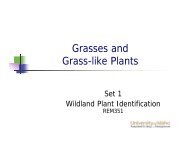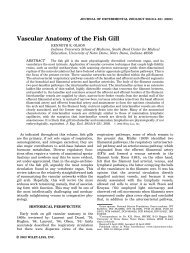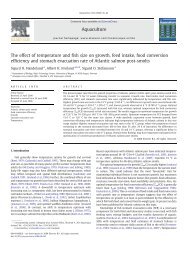Sage-grouse Habitat in Idaho - College of Natural Resources ...
Sage-grouse Habitat in Idaho - College of Natural Resources ...
Sage-grouse Habitat in Idaho - College of Natural Resources ...
Create successful ePaper yourself
Turn your PDF publications into a flip-book with our unique Google optimized e-Paper software.
with a healthy understory <strong>of</strong> grasses and forbs may<br />
eventually dom<strong>in</strong>ate the site and rema<strong>in</strong> until the next<br />
disturbance event. Healthy sagebrush landscapes<br />
are composed <strong>of</strong> a mosaic <strong>of</strong> these early, mid and late<br />
successional stages.<br />
Studies have shown that follow<strong>in</strong>g fire, recovery<br />
to pre-burn sagebrush cover can take from 25 to 75 years.<br />
Wyom<strong>in</strong>g big sagebrush has the slowest rate <strong>of</strong> recovery<br />
while mounta<strong>in</strong> big sagebrush usually recovers more<br />
quickly. However, as discussed on Pages 10 and 11, fire<br />
frequency and extent has <strong>in</strong>creased <strong>in</strong> sagebrush steppe,<br />
and recovery is <strong>in</strong>fluenced by <strong>in</strong>vasive annual grasses.<br />
In some areas, successional processes have been altered,<br />
and some sites may not recover to productive sage<strong>grouse</strong><br />
habitat. Throughout <strong>Idaho</strong>, private landowners<br />
and federal and state land managers are work<strong>in</strong>g hard to<br />
actively restore healthy sagebrush steppe habitats.<br />
Site Potential<br />
Even without disturbance, the distribution and<br />
abundance <strong>of</strong> sagebrush is variable across the landscape.<br />
Vegetation characteristics are generally determ<strong>in</strong>ed<br />
by physical elements such as elevation, precipitation,<br />
soil types, and aspect. Therefore, the variation <strong>in</strong> these<br />
physical elements across the landscape will naturally<br />
result <strong>in</strong> a variation <strong>in</strong> the types <strong>of</strong> habitats present.<br />
Some sites may never be capable <strong>of</strong> be<strong>in</strong>g productive<br />
sage-<strong>grouse</strong> nest<strong>in</strong>g habitat. For example, a dry southfac<strong>in</strong>g<br />
slope with shallow, rocky soils may not be able to<br />
grow suitable big sagebrush cover for nest<strong>in</strong>g. However,<br />
such a site may be capable <strong>of</strong> support<strong>in</strong>g other species<br />
<strong>of</strong> sagebrush or forbs that could provide forag<strong>in</strong>g<br />
opportunities dur<strong>in</strong>g other times <strong>of</strong> the year.<br />
<strong>Sage</strong>-Grouse <strong>Habitat</strong> <strong>in</strong> <strong>Idaho</strong><br />
<strong>Sage</strong>brush Steppe Plants 49





